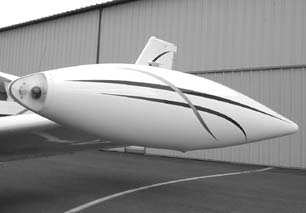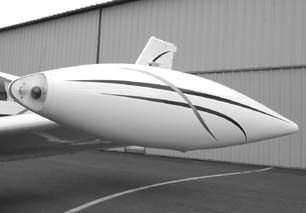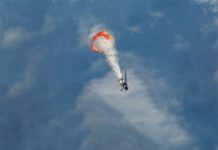
by Joseph E. (Jeb) Burnside
Some airplane owners can never have too much fuel. To them, its the ultimate expression of flexibility. To others, operating in the Alaskan bush, for example, extra fuel is a necessity. There may not be any fuel available at the river sandbar thats the destination. As a result, a thriving aftermarket has sprung up to certify and install belly tanks, fuselage tanks, cabin tanks and replacement, larger-capacity wing tanks.
In short, you can install an aux fuel tank to go just about anywhere in the airplane except the front left seat. The most popular is the wingtip-mounted fuel tank, although true tip tanks arent available for all models. And if yours is one for which tip tanks are available, you’ll be fortunate to have a choice of more than one manufacturer.
While adding tip tanks will not turn your Skylane into a Citation, this relatively simple modification can transform the average airplane into one in offering its operator greater range and flexibility. Following are some things you’ll want to consider when shopping for tip tanks.
Flexibility, Options
Often overlooked by an owner wanting to improve his or her airplane is the flexibility a pair of wingtip-mounted auxiliary fuel tanks can add to the average spam-can. Think about it: What can you do with as much as 50 percent more fuel? For one thing, you can fly further than you could before, we’ll beyond the limits of the average bladder.
You can also feed that thirstier, more-powerful engine or turbocharger you just installed. You can tanker fuel-top off at a distant airport with its dirt-cheap self-service fuel and thumb your nose at your home dromes sky-high fuel prices.
You can get to your destination more quickly because you wont need a fuel stop and you’ll have more than adequate reserves in situations where weather makes things tight. In the bargain, you can often get an increase in maximum gross takeoff weight.
Perhaps the greatest benefit a pair of tip tanks bestows is greater range and endurance. Instead of the 600- to 800-nautical mile range your airplane presently has, it could fly for 800 to 1000 miles or more. With any tailwind at all, that means west coast to east coast with one stop.
It also means fewer landings, which means reduced wear and tear on the landing gear, brakes, tires-and the pilot. Since many accidents happen during landing, fewer landings can mean improved safety. Even if you don’t want to fly that long a leg without stopping, the ability to do so opens up-dare we say it-a wider range of options than before adding tip tanks.
Internal or External?
While several manufacturers offer aftermarket tip tanks, they basically fall into two categories: external or internal. The internals arent always considered true tip tanks since they sometimes fill out existing wing bays inboard of the tips. In any case, internal tanks can offer little or no drag penalties but if the tip tank addition doesnt involve extending the wings span, it also wont offer the additional lift sometimes ascribed to external tip tanks.
Obviously, an internal tip tank can only be mounted in a wing with some empty space inside. Examples of airframes eligible for internal tanks include some Cessna singles and twins plus some Mooneys. Most of the time, retaining existing wing tips and navigation/strobe lights is possible with an internal tank. Other airframes can benefit not by installing a separate tank in the wingtip but by replacing the original tanks with larger ones. Once again, these arent true tips.
As the term implies, adding external tip tanks replaces your factory wing tips. Metal tubing is run through the wings and the tanks are bolted to existing mounts after the factory wingtips are removed. The external tank will also include provisions for navigation lights and, sometimes as an option, strobes. The tanks are basically self-contained, with their own filler caps, vent systems and sumps. These are popular on Bonanzas, Piper single and Twin Comanches and Navions. Often the type of aircraft will dictate the type of tip tank: Internal tanks are not available for the Bonanza while external ones cant be found for the Cessna 172.
Regardless of whether the tank is mounted internally or externally, fuel has to get from the tip to the engine. This design option also comes in two flavors: Tips can be plumbed directly to the fuel selector or used to replenish a factory fuel tank. Again, depending on airframe, you may not have a choice of plumbing. In any event, the connections between the tanks and either the fuel selector or that wings main fuel tank will be through high-quality metal tubing with appropriate fittings and hoses. Tips plumbed directly to the fuel selector eliminate the need to add transfer pumps-as we’ll as the pumps weight and wiring-to the installation, but can increase the fuel management workload. And unless youre willing to run a tank dry, you’ll never be able to use all the fuel on board.
Some installations may allow takeoff on a tip; other installations may return excess fuel from the engine to only one tank, rather than the tank selected. Also, a new fuel selector may be required, increasing installation costs.
Using electric pumps to replenish fuel in the main tanks brings its own fuel management issues: If there isn’t room for the fuel youre pumping from the tip to the main, it will go overboard. More than one tip-tank equipped pilot has dumped a few hours of range over the side. One soon learns to delay transferring fuel to a main tank until enough has burned off.
Another shortcoming of the pump transfer design is that a failed pump can result in a fuel imbalance and a heavy wing. Further, the fuel you expected to burn on a max-range flight cant be accessed if a pump isn’t working. Using a transfer system also involves mounting the transfer pumps and supplying them with ships power, increasing the installation cost and raising the probability of leaks and electrical faults.
As a rule, two kinds of materials are used for tip tanks. Both have pros and cons. Aluminum is better understood by the average A&P, making any repairs easier to find and pay for. Aluminum tanks generally cost more to purchase in those rare occasions where you have the choice of materials.
Fiberglass tanks can be cheaper but are more difficult to repair in the field if they get dinged. This presumes you even have the choice and for many airframes, you wont.
Differences, Aerodynamics
In either instance, other things to consider involve gauging, capacities and any operating limitations the installation may impose (more on this latter point below). Most tip tanks offer the pilot some method to determine how much fuel is in the tips from the cockpit. Electric gauges are popular, some including a single instrument toggled between a sending unit in each tank.
Some manufacturers build in a sight gauge. Beryl DShannons (BDS) fiberglass tip tanks for the Beech Bonanza/Debonair line include a translucent vertical panel easily viewed from the left seat. This allows the pilot to instantly determine both how much fuel is in the tank and whether its being transferred. This arrangement saves weight and money by eliminating gauges and wiring as we’ll as the costs to install them.
Total capacities of popular tip tanks normally range from 10 or 12 gallons for 100-series Cessnas (Flint Aero) to 24 gallons each for the Piper Apache/Aztec (Met-Co-Aire). Usable fuel will be slightly less. Anyway you cut it, that means an easy 2.5 hours of additional fuel, often more.
Aerodynamics
Any time one adds weight at the tip of a wing or extends its span, the airplanes handling also changes. Most of the time, stability improves while roll rate suffers. Unless youre a brave and trusting soul who uses your Skyhawk for aerobatics, adding tip tanks shouldnt have any impact on your airplanes handling in day-to-day, cross-country flying. This is true whether the tanks have fuel in them or not.
When the tanks are filled-regardless of whether they are of the internal or external variety-stability will increase since there’s more mass to be displaced by wind gusts or aileron inputs. Similarly, roll rate will suffer as more mass is placed out on the end of the wing without changing the ailerons effectiveness. Some tip tank suppliers attempt to compensate for this by requiring different aileron balance weights. The tanks supplied for some models of the Bonanza line by BDS include these weights.
Tip tank aerodynamics depend on the installation method. An internal tank installation that does not involve extending the wing shouldnt produce a measurable difference. In this instance, the only external changes to the wing are a fuel filler, usually hidden behind a hinged door on the wings upper surface and a recessed drain on the lower surface to facilitate sumping the tank.
With both external and internal tank designs that effectively involve a wingtip extension, the aerodynamics change. In the latter case, obviously, the wing gets longer. The result is predictable: Extend a given wings span and both lift and induced drag-a by-product of lift generation-increase. Parasitic drag-the kind produced by hanging something out in a breeze-will also increase.
The trick is figuring out how to operate the longer-wing airplane in a fashion that both minimizes parasitic drag and takes advantage of the longer span.
In the case of external tip tanks, it gets interesting: Adding a rather bulbous structure will increase parasitic drag. At the same time, the wing effectively gets a little longer. While the overall span may not change appreciably, something else-known as the end-plate effect-can come into play. End-plate effect, sometimes ascribed to winglets, affects the wing in two ways. The first is to reduce, slightly, induced drag by messing with the wingtip vortices. In the bargain, parasitic drag increases, since there’s a marginal increase in the wings span.
In both cases, parasitic drag increases by either extending the wingspan, by sticking a new, large object out on the tip, or both. How can this be overcome in normal operations? Well, Aerodynamics 101 tells us that slowing down can mean reductions in parasitic drag. Similarly, all things being roughly equal, the best place to operate a long wing of a given airfoil, when compared with its shorter sibling, is at a higher altitude. Interestingly, indicated or calibrated airspeed decreases (the airplane effectively slows down) at higher altitudes, even though true airspeed increases. As one result for the same power setting, both induced and parasitic drag are reduced at higher altitudes since the indicated airspeed is lower.
Magically, then, the best place to operate an airplane equipped with either extended wingtips containing fuel tanks or external tip-mounted tanks is at a higher altitude. Conveniently, the typical cross-country cruiser is going to be flown at the highest altitude practical for the trip length. Generally, the air is smoother, the chance of picking up a tailwind is greater and there’s less traffic.
One conclusion is that the drag produced by adding an external tip tank or wingtip extension containing fuel can best be overcome by flying the airplane at as high an altitude as is practical for the leg being flown. Since most owners buy tip tanks to fly longer distances, theyll usually fly higher than before.
What does all this mean in the real world? Not a whole lot. For example, Bonanza owners admit to losing a knot or two at low altitudes after installing external tip tanks. They also report picking up a knot or two, or at least recovering the knots lost when cruising at higher altitude, say 10,000 feet. And, of course, they can stay there longer if the tanks are filled.
Weight and Limitations
As noted earlier, many tip tank installations include an increase in the airplanes maximum gross takeoff weight (MGTOW). This increase varies from one airframe to another and from one tank manufacturer to another, but can be substantial.
One example of this increase is in the Bonanza/Debonair line. For example, a 1966 V35 Bonanza originally left Wichita with a MGTOW of 3400 pounds. Adding a pair of BDS tip tanks to this airframe includes a 250-pound MGTOW increase.
There being no free lunch, the airplane must be operated in the Normal category, instead of the Utility category in which it left the factory. This means a change in the operating limitations by lowering the airframes maneuvering speed, a change with little practical impact in the way in which these airplanes are routinely operated. The installed tanks weigh around 27 pounds, so the aircraft has an increased useful load of 223 pounds.
Again, depending on the airframe, there may be a limitation on how that increased useful load can be used. On my 1966 Beech C33A Debonair, for example, the 223-pound useful load increase is available by installing the BDS tips. However, one of the operating limitations is that at least 100 pounds of the MGTOW must be fuel in the tip tanks.
Other manufacturers tip tanks added to other airframes may include similar-or completely unrelated-limitations. As always, when considering a modification of this type, ask the manufacturer for a copy of any POH or AFM supplements and review them before pulling out the plastic to place your order.
Last Word
As with any major change to an airplane (and despite the relative ease with which it can be accomplished, this is a major change), careful consideration of all the pros and cons is critical.
If your flying is mostly within a couple hundred miles of your base in search of the perfect airport hamburger, then adding a pair of tip tanks probably isn’t for you, given the considerable cost involved.
On the other hand, if you regularly use your airplane for reliable business or personal transportation, upping your fuel capacity makes sense. It can be both a time and a money saver.
Even if you or a regular passenger have limited interest in staying aloft for more time than your airplanes standard fuel capacity allows, the extra gallons available can mean much less anxiety when headwinds are stronger than forecast or the destination weather goes down the tubes.
And then there’s the capability to, say, reach Key West from just about anywhere east of the Mississippi River without having to stop.
All it takes is money.
Also With This Article
“Checklist”
“Some Real-World Numbers”
“Sources”
-Joseph E. (Jeb)) Burnside is a freelance writer and editor. He lives in the Washington, D.C. area.





